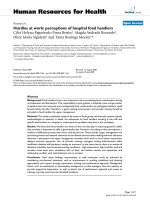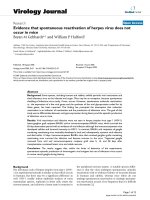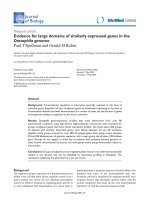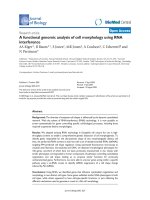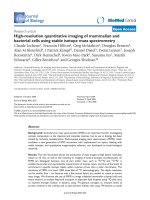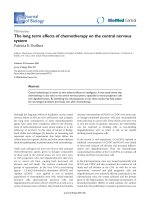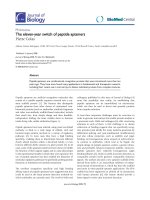Báo cáo sinh học: "Distant metastasis: not out of reach any mor" pot
Bạn đang xem bản rút gọn của tài liệu. Xem và tải ngay bản đầy đủ của tài liệu tại đây (69.52 KB, 5 trang )
Minireview
DDiissttaanntt mmeettaassttaassiiss:: nnoott oouutt ooff rreeaacchh aannyy mmoorree
François Bertucci*
†§
and Daniel Birnbaum*
Address: *Centre de Recherche en Cancérologie de Marseille, laboratoire d’Oncologie Moléculaire; UMR891 Inserm; Institut
Paoli-Calmettes, 13009 Marseille, France.
†
Département d’Oncologie Médicale, Institut Paoli-Calmettes, 13009 Marseille, France.
§
Faculté de Médecine, Université de la Méditerranée, Marseille, France.
Correspondence: Daniel Birnbaum. Email:
Breast cancer is the second leading cause of cancer-asso-
ciated mortality in women in Western countries. The main
event leading to death in breast cancer patients is the
development of metastases - secondary locations of cancer
cells in sites distant from the primary tumor. Today, the
number of patients with metastatic breast cancer has
declined, thanks largely to improvements in the systemic
adjuvant treatment of early-stage disease, designed to eradi-
cate micrometastases. Nevertheless, approximately 6-10%
of patients have metastatic disease at the time of diagnosis
and 30% of initially non-metastatic patients will eventually
develop metastatic relapse. The prognosis for these patients
is poor, with an estimated 5-year survival of only 21%.
Despite a wealth of studies, metastasis is not well under-
stood and is poorly controlled clinically. Recent data have
suggested that the capacity to metastasize is due to factors
both extrinsic and intrinsic to the tumor cells [1]. Intrinsic
factors are associated with tumor-cell aggressiveness. Extrinsic
factors are associated with the peritumoral stroma, immune
response and neo-angiogenesis, and probably include other,
more elusive factors linked to treatment response or host
susceptibility. It is clear that therapeutic targeting of both is
needed to prevent and to treat metastasis. This is clinically
evident by the efficacy of bevacizumab, a monoclonal anti-
body against vascular endothelial growth factor (VEGF), in
combination with chemotherapy in treating metastatic
breast, lung and colon cancers.
The potential of a tumor to metastasize can be detected
early and before the occurrence of metastasis by using gene-
expression profiling [2]. This finding challenged the original
idea that metastases arise from cells within the primary
tumor that have acquired the ability to metastasize after a
stepwise accumulation of alterations and release of host
barriers. In breast cancer, at least five molecular subtypes
(luminal A, luminal B, basal, ERBB2+ and normal-like)
have been identified and display different propensities to
metastasize, and prognostic multigene expression signatures
have been established.
These signatures are valuable in two ways. First, they can be
used in the clinic to guide treatment. Second, they provide
clues to understanding the metastatic process. Two recent
articles, published in BMC Medicine and in BMC Cancer,
report prognostic gene-expression signatures associated,
AAbbssttrraacctt
Metastasis is the major cause of death in breast cancer patients. Gene-expression studies have
shown that the likelihood of metastasis can be predicted from analysis of primary tumors. Two
recent papers in
BMC Medicine
and
BMC Cancer
have established new operational expression
signatures containing a limited number of genes involved in angiogenesis or cell proliferation.
Journal of Biology
2009,
88::
28
Published: 27 March 2009
Journal of Biology
2009,
88::
28 (doi:10.1186/jbiol128)
The electronic version of this article is the complete one and can be
found online at />© 2009 BioMed Central Ltd
respectively, with distant metastases and with the metastatic
potential of breast cancer. These studies improve our know-
ledge of metastasis and propose means to detect it.
AA 1133 ggeennee sseett aassssoocciiaatteedd wwiitthh ttuummoorr rreessppoonnssee ttoo
hhyyppooxxiiaa aanndd mmeettaassttaassiiss
Hu et al. [3] used gene-expression analysis by DNA micro-
arrays to compare a series of primary tumors and meta-
stases. They established a clinical ‘MetScore’ that combines
lymph-node status and metastasis status at time of diag-
nosis and ranges from 0 (negative for both node and
distant metastasis) to 3 (distant metastasis present). They
show that distant metastases are, at the whole-genome
transcriptional level, more distinct from non-metastatic
primary tumors and regional metastases than the latter are
to each other. They determined a set of 1,195 genes whose
expression was associated with a MetScore. When the gene
set was used to classify samples by hierarchical clustering, a
subset of non-distant metastatic primary tumors
(MetScores 1 and 2) resembled distant metastases. As
expected from previous prognostic studies, basal and
ERBB2+ tumors correlated most highly with MetScore 3.
Several gene clusters were identified within the gene set,
none of which perfectly correlated with transition from
MetScore 1 to 2 to 3, indicating the complexity of the
phenomenon. These included an estrogen-receptor (ER)-
related gene cluster, weakly associated with MetScores 1-2,
and a proliferation cluster.
A small cluster of 13 genes highly associated with MetScore
3 was also detected (Table 1), which included three genes
coding for angiogenic factors: VEGFA; adrenomedullin
(ADM); and angiopoietin-like 4 (ANGPTL4). Eight of the
genes contain binding sites for the hypoxia-induced factor 1
alpha (HIF1A) in their regulatory regions and, as expected, a
strong correlation was noted between the mRNA expression
of HIF1A and the ‘VEGF profile’ - defined as the average
expression values across all 13 genes. In situ hybridization
showed that it was the tumor cells that expressed mRNA of
the three angiogenic factors, and thus the 13-gene cluster
seemed to be related to tumor-cell response to hypoxic
conditions. When applied to the 134 primary tumors, the
VEGF profile was predictive of relapse-free survival and
overall survival, with high expression associated with poor
outcome. This was validated in an external series of breast
tumors, and also in lung cancer and glioblastoma, further
supporting the idea that different tumor types have similar
pathways to metastasis. In the breast cancer series (295
patients), the VEGF profile remained an independent
prognostic feature in multivariate analysis incorporating
classical prognostic features, the molecular subtypes and
multiple other expression predictors.
Other factors were associated with the MetScore, including the
molecular subtype, a fibroblast signature associated with a low
MetScore, and a signature involving the TWIST gene and a
‘glycolysis profile’ associated with a high MetScore, suggesting
that the distant metastatic samples not only promote angio-
genesis but also survive under anerobic conditions.
AA 1144 ggeennee sseett aassssoocciiaatteedd wwiitthh cceellll pprroolliiffeerraattiioonn aanndd
ddiissttaanntt mmeettaassttaassiiss
The study by Tutt et al. [4] addressed the same question
using different samples and tools, and the more classical
approach of supervised analysis. The aim was to identify an
expression signature predictive of distant metastatic relapse
after loco-regional treatment alone, without any adjuvant
systemic treatment. The authors studied a series of 421
systemically untreated breast carcinomas consisting of a
training set of 142 samples and a validation set of 279
samples. The major differences from Hu et al. [3] were that
all the samples were primary tumors, all ER-positive and
lymph-node negative, the patients were homogeneously
treated, the mRNAs were extracted from formalin-fixed
paraffin-embedded (FFPE) samples, the method used PCR
amplification of mRNA from a priori selected genes, and the
supervised analysis compared tumors without versus
tumors with metastatic relapse.
An initial selection of 197 prognosis- and prediction-
associated genes was based on four recently published prog-
nostic expression signatures. The gene list went down to 37
after a first supervised analysis of the training set (univariate
Cox analysis) and was further reduced to 14 after regression
analysis. Nine of these 14 genes (Table 1) are associated
with cell proliferation and 10 with the TP53 pathway, as
determined by ontology analysis. A metastatic score (MS)
was established based on the linear combination of expres-
sion values across the 14 genes, and represented the
probability of a tumor metastasizing. High MS was associa-
ted with an increased risk of distant metastasis and an
increased risk of death. Using MS it was possible to separate
patients into two groups - low and high risk of metastasis -
with different distant metastasis-free survival and overall
survival in both training and validation sets. The perfor-
mances of the predictor were similar in the two sample sets.
For example, the hazard ratio for risk of distant metastasis
in the high risk group as compared to the low risk group
was 4.34 in the training set and 4.71 in the validation set, in
univariate analysis. Furthermore, MS remained significant
in multivariate analysis after adjustment for classical
prognostic factors, whereas the Ki67 index, a marker of
proliferation, was no longer significant. Finally, comparison
with the histo-clinical Adjuvant! Online predictor showed
that the MS provided additional prognostic information.
28.2
Journal of Biology
2009, Volume 8, Article 28 Bertucci and Birnbaum />Journal of Biology
2009,
88::
28
Although the list of genes from Tutt et al. [4] adds no new
information to existing signatures, this study is especially
valuable for its use of methods and samples appropriate for
routine laboratories, such as FFPE tumors and PCR ampli-
fication, for the limited number of genes, and for a broader
age range of the patients.
LLoonngg ddiissttaannccee ccaallll:: ttrreeaattiinngg aanndd pprreeddiiccttiinngg mmeettaassttaassiiss
Understanding the biology behind distant metastasis will
not only help to design drugs to treat it and, even better, to
prevent it, but also provide better ways to detect it and
predict it. The two prognostic signatures, related to
angiogenesis and proliferation, respectively, confirm the
relevance of these biological processes in cancer
progression and also the superiority of multigene versus
single gene analysis. Indeed, multivariate analysis shows
that the signature of Tutt et al. [4] provides additional
prognostic information compared with the Ki67
proliferation marker. We compared these two signatures
with our basal versus luminal A breast cancer signature [5],
and found that 10 out of 13 genes from the Hu et al.
signature [3] and 10 out of 14 genes from the Tutt et al.
signature [4] were overexpressed in basal breast tumors
(Table 1), in agreement with the poorer prognosis of
this subtype.
/>Journal of Biology
2009, Volume 8, Article 28 Bertucci and Birnbaum 28.3
Journal of Biology
2009,
88::
28
TTaabbllee 11
TThhee 2277 ggeenneess iinncclluuddeedd iinn tthhee ttwwoo ssiiggnnaattuurreess
Hu
et al
. Tutt
et al.
Gene symbol Gene name [3] [4] Basal* 16-kinases
†
GGI
‡
ADM
Adrenomedullin Yes Up
ANGPTL4
Angiopoietin-like 4 Yes
C14orf58
Chromosome 14 open reading frame 58 Yes Up
DDIT4
DNA-damage-inducible transcript 4 Yes Up
FABP5
Fatty acid binding protein 5 (psoriasis-associated) Yes Up
GAL
Galanin Yes Up
NDRG1
N-myc downstream regulated gene 1 Yes Up
NP
Nucleoside phosphorylase Yes Up
PLOD1
Procollagen-lysine 1,2-oxoglutarate 5-dioxygenase 1 Yes Up
RRAGD
Ras-related GTP binding D Yes Up
SLC16A3
Solute carrier family 16 (monocarboxylic acid transporters), member 3 Yes
UCHL1
Ubiquitin carboxyl-terminal esterase L1 (ubiquitin thiolesterase) Yes Up
VEGF
Vascular endothelial growth factor Yes Up
BUB1
BUB1 budding uninhibited by benzimidazoles 1 homolog (yeast) Yes Up Yes Yes
CCNB1
Cyclin B1 Yes Up Yes
CENPA
Centromere protein A, 17 kDa Yes Up Yes
DC13
DC13 protein Yes Yes
DIAPH3
Diaphanous homolog 3 (Drosophila) Yes
MELK
Maternal embryonic leucine zipper kinase Yes Up Yes
MYBL2
v-Myb myeloblastosis viral oncogene homolog (avian)-like 2 Yes Up Yes
ORC6L
Origin recognition complex, subunit 6 like (yeast) Yes Up
PKMYT1
Protein kinase, membrane associated tyrosine/threonine 1 Yes Up
PRR11
Proline rich 11 Yes
RACGAP1
Rac GTPase activating protein 1 Yes
RFC4
Replication factor C (activator 1) 4, 37 kDa Yes Up
TK1
Thymidine kinase 1, soluble Yes
UBE2S
Ubiquitin-conjugating enzyme E2S Yes Up
*Genes upregulated in basal versus luminal A tumors [5];
†
16-kinase signature [8];
‡
genomic grade index [7].
RReelleevvaannccee ffoorr ttrreeaattmmeenntt
Metastasis is due to a combination of tumor and host
factors, with diverse interactions between cancer cells and
their microenvironment. One such factor might be the
existence of specific cells such as cancer stem cells (CSCs)
that fuel the primary tumor. With potential for self-renewal
and migration, these cells can leave the primary tumor to
colonize distant organs. The study by Hu et al. shows that
hypoxia may be important in this process, as it might
stimulate CSCs to migrate and look for better conditions.
Hypoxia also promotes neo-angiogenesis, which offers new
routes for CSCs to leave the tumor. Correlation with the
‘TWIST’ signature is not surprising as TWIST is regulated by
HIF1A. Some proteins of the VEGF signature, such as ADM
and ANGPTL4, represent molecular targets under investi-
gation that could help increase our therapeutic armament
against metastatic breast cancer.
The study by Tutt et al. [4] shows that proliferation is a
marker of breast cancer aggressiveness. This is now well
accepted, in particular for ER-positive breast cancer [6].
Proliferative subtypes, such as basal and luminal B cancers,
are associated with a poor outcome. The definitions of a
genomic grade [7] or mitotic kinase index [8] have strength-
ened this notion. Five and two genes of the signature of Tutt
et al. were part of these two signatures, respectively (Table 1).
Targeting cell proliferation is a main objective of anticancer
therapeutic strategies. Kinases have proved successful targets
for therapy and some mitotic kinases of the Tutt 14-gene
signature are under investigation as therapeutic targets:
MELK, MYT1, TK1 and BUB1.
RReelleevvaannccee ffoorr pprreeddiiccttiioonn
The two new studies confirm that distant metastasis can be
predicted using expression profiles, thus helping physicians
to select an appropriate therapy. Three approaches to
obtaining gene signatures are in general use. In the first
(‘top-down’), the expression profiles of two groups of
patients are compared to identify genes associated with
metastatic relapse without any a priori biological hypothesis.
Consequently, the signature obtained does not necessarily
contain key biological information related to metastasis.
This method has produced at least two prognostic signa-
tures in node-negative breast cancer untreated with adjuvant
chemotherapy: the Amsterdam 70-gene signature [9] and
the Rotterdam 76-gene signature [10]. The second approach
(‘bottom-up’) first identifies a signature associated with a
specific biological hypothesis or a phenotypic feature
relevant to the metastatic process, and then tests for its
correlation with outcome, providing additional insight
into the biological mechanisms and possible therapeutic
targets. Prognostic signatures associated with wound
repair, stem cells, hypoxia or pathological grade [7] have
been established this way [2]. The study by Hu et al. [3] is
an example of this approach based on the initial
comparison of non-metastatic versus metastatic samples or
metastases. In a similar study, Ramaswamy et al. [11]
identified a metastasis signature prognostically informative
in several tumor types. By supervised analysis, Paik et al.
[12] identified a multigene predictor of metastatic relapse in
ER-positive breast cancer treated with adjuvant hormone
therapy. This approach is used by Tutt et al. [4] in a series of
patients similar to those of Paik et al. [12] but not treated
with any adjuvant systemic therapy. The clinical interest of
this ‘pure’ prognostic signature may be for low-risk patients,
not only to avoid unnecessary adjuvant chemotherapy (as
does the Paik signature) but also to avoid hormone therapy
and its sometimes troublesome toxicity.
Predicting tumor aggressiveness and metastasis is a crucial
step in the management of breast cancer. It is expected that
a sensitive and specific molecular barcode will result from
this kind of study. The ultimate dream of physicians is to
use this barcode to select a drug from the ‘inpharmatics’
vending machine to treat each particular patient.
AAcckknnoowwlleeddggeemmeennttss
Our work is supported by Inserm, Institut Paoli-Calmettes and grants
from Ligue Nationale Contre le Cancer (Label DB) and Institut National
du Cancer.
RReeffeerreenncceess
1. Chiang AC, Massague J:
MMoolleeccuullaarr bbaassiiss ooff mmeettaassttaassiiss
N Engl J Med
2008,
335599::
2814-2823.
2. Sotiriou C, Pusztai L:
GGeennee eexxpprreessssiioonn ssiiggnnaattuurreess iinn bbrreeaasstt ccaanncceerr
N Engl J Med
2009,
336600::
790-200.
3. Hu Z, Fan C, Livasy C, He X, Oh DS, Ewend MG, Carey LA, Sub-
ramanian S, West R, Ikpatt F, Olopade OI, van de Rijn M, Perou
CM:
AA ccoommppaacctt VVEEGGFF ssiiggnnaattuurree aassssoocciiaatteedd wwiitthh ddiissttaanntt mmeettaassttaasseess
aanndd ppoooorr oouuttccoommee
BMC Med
2009,
77
:9.
4. Tutt A, Wang A, Rowland C, Gillett C, Lau K, Chew K, Dai H,
Kwok S, Ryder K, Shu H, Springall R, Cane P, McCallie B, Kam-
Morgan L, Anderson S, Buerger H, Gray J, Bennington J, Esserman
L, Hastie T, Broder S, Sninsky J, Brandt B, Waldman F:
RRiisskk eessttiimmaa
ttiioonn ooff ddiissttaanntt mmeettaassttaassiiss iinn nnooddee nneeggaattiivvee,, eessttrrooggeenn rreecceeppttoorr ppooss
iittiivvee bbrreeaasstt ccaanncceerr ppaattiieennttss uussiinngg aann RRTT PPCCRR bbaasseedd pprrooggnnoossttiicc
eexxpprreessssiioonn ssiiggnnaattuurree
BMC Cancer
2008,
88::
339.
5. Bertucci F, Finetti P, Cervera N, Charafe-Jauffret E, Buttarelli M,
Jacquemier J, Chaffanet M, Maraninchi D, Viens P, Birnbaum D:
HHooww ddiiffffeerreenntt aarree lluummiinnaall AA aanndd bbaassaall bbrreeaasstt ccaanncceerrss??
Int J Cancer
2009,
112244::
1338-1348.
6. Desmedt C, Sotiriou C:
PPrroolliiffeerraattiioonn:: tthhee mmoosstt pprroommiinneenntt pprreeddiicc
ttoorr ooff cclliinniiccaall oouuttccoommee iinn bbrreeaasstt ccaanncceerr
Cell Cycle
2006,
55::
2198-
2202.
7. Sotiriou C, Wirapati P, Loi S, Harris A, Fox S, Smeds J, Nordgren
H, Farmer P, Praz V, Haibe-Kains B, Desmedt C, Larsimont D,
Cardoso F, Peterse H, Nuyten D, Buyse M, Van de Vijver MJ,
Bergh J, Piccart M, Delorenzi M:
GGeennee eexxpprreessssiioonn pprrooffiilliinngg iinn
bbrreeaasstt ccaanncceerr:: uunnddeerrssttaannddiinngg tthhee mmoolleeccuullaarr bbaassiiss ooff hhiissttoollooggiicc
ggrraaddee ttoo iimmpprroovvee pprrooggnnoossiiss
J Natl Cancer Inst
2006,
9988::
262-272.
8. Finetti, P, Cervera, N, Charafe-Jauffret, E, Chabannon, C, Charpin,
C, Chaffanet, M, Jacquemier, J, Viens, P, Birnbaum, D, Bertucci, F:
SSiixxtteeeenn kkiinnaassee ggeennee eexxpprreessssiioonn iiddeennttiiffiieess lluummiinnaall bbrreeaasstt ccaanncceerrss
wwiitthh ppoooorr pprrooggnnoossiiss
Cancer Res
2008,
6688::
767-776.
28.4
Journal of Biology
2009, Volume 8, Article 28 Bertucci and Birnbaum />Journal of Biology
2009,
88::
28
9. van de Vijver MJ, He YD, van’t Veer LJ, Dai H, Hart AA, Voskuil
DW, Schreiber GJ, Peterse JL, Roberts C, Marton MJ, Parrish M,
Atsma D, Witteveen A, Glas A, Delahaye L, van der Velde T,
Bartelink H, Rodenhuis S, Rutgers ET, Friend SH, Bernards R:
AA
ggeennee eexxpprreessssiioonn ssiiggnnaattuurree aass aa pprreeddiiccttoorr ooff ssuurrvviivvaall iinn bbrreeaasstt
ccaanncceerr
N Engl J Med
2002,
334477::
1999-2009.
10. Wang Y, Klijn JG, Zhang Y, Sieuwerts AM, Look MP, Yang F, Talan-
tov D, Timmermans M, Meijer-van Gelder ME, Yu J, Jatkoe T,
Berns EM, Atkins D, Foekens JA:
GGeennee eexxpprreessssiioonn pprrooffiilleess ttoo
pprreeddiicctt ddiissttaanntt mmeettaassttaassiiss ooff llyymmpphh nnooddee nneeggaattiivvee pprriimmaarryy bbrreeaasstt
ccaanncceerr
Lancet
2005,
336655::
671-679.
11. Ramaswamy S, Ross KN, Lander ES, Golub TR:
AA mmoolleeccuullaarr ssiiggnnaattuurree
ooff mmeettaassttaassiiss iinn pprriimmaarryy ssoolliidd ttuummoorrss
Nat Genet
2003,
3333::
49-54.
12. Paik S, Shak S, Tang G, Kim C, Baker J, Cronin M, Baehner FL,
Walker MG, Watson D, Park T, Hiller W, Fisher ER, Wickerham
DL, Bryant J, Wolmark N:
AA mmuullttiiggeennee aassssaayy ttoo pprreeddiicctt rreeccuurrrreennccee
ooff ttaammooxxiiffeenn ttrreeaatteedd,, nnooddee nneeggaattiivvee bbrreeaasstt ccaanncceerr
N Engl J Med
2004,
335511::
2817-2826.
/>Journal of Biology
2009, Volume 8, Article 28 Bertucci and Birnbaum 28.5
Journal of Biology
2009,
88::
28

